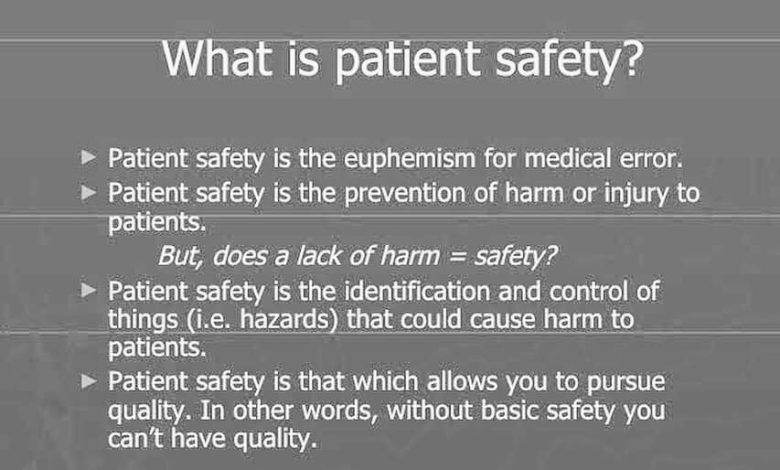Patient Safety: Definition, Principles, Importance, Examples

Definition of Patient Safety
Patient safety refers to the prevention of errors and adverse effects that may arise from healthcare delivery to patients. It involves minimizing the risk of harm to patients while receiving medical care, whether it be during diagnosis, treatment, or follow-up care. Patient safety involves a wide range of factors, including the design and management of healthcare systems, the competence and performance of healthcare providers, and the involvement and education of patients.
The ultimate goal of patient safety is to ensure that patients receive the highest quality of care with minimal harm and that healthcare providers continuously work towards improving patient safety through ongoing learning, education, and implementation of the best practices. According to the World Health Organization, as many as 4 in 10 patients are harmed in primary and outpatient health care and up to 80% of the harm is preventable. The most detrimental errors are related to diagnosis, prescription, and the use of medicines
There are many examples of patient safety practices in healthcare. Here are some examples:
- Medication reconciliation: Healthcare providers perform medication reconciliation to ensure that patients receive the correct medications at the correct doses, and to prevent medication errors. This involves reviewing a patient’s medication history, verifying current medications, and resolving any discrepancies.
- Hand hygiene: Healthcare providers perform hand hygiene, including hand washing and the use of alcohol-based hand rubs, to prevent the spread of infections.
- Surgical safety checklists: Surgical safety checklists are used to reduce the risk of surgical errors, such as wrong site surgery, by ensuring that all necessary steps are taken before, during, and after a procedure.
- Patient education: Patients are educated about their condition and treatment options to help them participate in their care and make informed decisions.
- Fall prevention: Healthcare providers take measures to prevent falls, such as using bed rails, providing non-slip footwear, and using appropriate lighting.
- Root cause analysis: Healthcare organizations conduct root cause analyses to identify the underlying causes of adverse events and to develop strategies to prevent future occurrences.
These are just a few examples of patient safety practices in healthcare. By implementing these and other practices, healthcare providers and organizations can improve patient safety and reduce the risk of harm to patients.
What are patient safety principles?
Patient safety principles are a set of guidelines that healthcare providers and organizations follow to ensure the safety of patients receiving medical care. The principles include:
1. Patient-Centeredness: Patients are at the center of care, and their preferences and needs are taken into account.
2. Systems Approach: The healthcare system is designed and managed to provide safe and high-quality care.
3. Teamwork and Collaboration: Effective communication and teamwork are essential for delivering safe care.
4. Evidence-Based Practice: Healthcare providers use the best available evidence to inform their practice.
5. Continuous Learning: Healthcare providers engage in ongoing learning and improvement to enhance patient safety.
6. Transparency: Open and honest communication is critical for identifying and addressing errors and adverse events.
7. Patient and Family Involvement: Patients and their families are actively involved in their care and encouraged to participate in decision-making.
By following these patient safety principles, healthcare providers can ensure that they provide safe and high-quality care to their patients.
What are the components of patient safety?
The components of patient safety are as follows:
1. Identifying and mitigating risks: The first step in ensuring patient safety is to identify potential risks and take steps to mitigate them. This includes identifying factors that can contribute to medical errors, such as communication breakdowns, medication errors, and inadequate staffing levels.
2. Creating a culture of safety: Patient safety requires a culture that values safety and encourages open communication, transparency, and learning from mistakes. This culture should support the reporting of errors and near-misses, and the implementation of changes to prevent similar incidents from occurring in the future.
3. Ensuring effective communication: Effective communication between patients, their families, and healthcare providers is critical for ensuring patient safety. Healthcare providers should use clear and concise language and encourage patients to ask questions and voice concerns.
4. Providing education and training: Healthcare providers should receive ongoing education and training on patient safety best practices and how to effectively communicate with patients and their families.
5. Implementing evidence-based practices: Healthcare providers should use evidence-based practices that are known to improve patient safety, such as medication reconciliation, hand hygiene, and fall prevention strategies.
6. Using technology to enhance patient safety: Technology can be used to enhance patient safety by automating processes, reducing the risk of medication errors, and improving communication between healthcare providers.
By addressing these components, healthcare organizations and providers can work together to ensure that patients receive safe and high-quality care.
Factors Affecting Patient Safety
There are many factors that can affect patient safety, including:
1. Communication breakdowns: Communication failures can occur between patients and healthcare providers, as well as between different healthcare providers. These breakdowns can lead to errors, misinterpretations, and delays in treatment.
2. Medication errors: Medication errors can occur when the wrong medication is prescribed, the wrong dose is administered, or when a medication is given to a patient who is allergic to it. These errors can cause serious harm to patients, including adverse drug reactions and death.
3. Inadequate staffing levels: Inadequate staffing levels can lead to overworked healthcare providers, which can result in errors, burnout, and poor-quality care.
4. Infection control: Infections acquired in healthcare settings, such as hospitals, can lead to serious harm to patients. Proper infection control measures, such as hand hygiene and proper use of personal protective equipment, are essential for preventing the spread of infections.
5. Diagnostic errors: Diagnostic errors can occur when healthcare providers fail to correctly diagnose a patient’s condition, leading to delayed or inappropriate treatment.
6. System failures: System failures, such as malfunctioning equipment or flawed processes, can lead to errors and harm to patients.
7. Patient factors: Patient factors, such as age, medical history, and comorbidities, can also affect patient safety. For example, older patients may be more susceptible to falls, and patients with multiple medical conditions may be at higher risk for medication errors.
By understanding these factors, healthcare providers and organizations can work to implement measures to mitigate risks and enhance patient safety.
What are the 5 steps to improving patient safety?
The Institute for Healthcare Improvement (IHI) has identified five steps to improving patient safety, known as the “5 Steps to Safer Healthcare.” These steps are:
1. Identify patients: Ensure that patients are accurately identified, using at least two patient identifiers, such as name and date of birth.
2. Improve communication: Promote effective communication between healthcare providers, patients, and their families. This includes using clear and concise language, active listening, and responding to patient concerns.
3. Use medications safely: Ensure that medications are used safely, by using best practices for medication reconciliation, prescribing, and administration. This includes verifying medication orders, using bar code scanning, and providing patient education.
4. Use alarms safely: Ensure that alarms are used safely, by setting appropriate alarm limits, minimizing alarm fatigue, and addressing alarm signals in a timely manner.
5. Prevent infections: Use evidence-based infection prevention practices, such as hand hygiene, proper use of personal protective equipment, and appropriate sterilization and disinfection practices.
By following these five steps, healthcare providers and organizations can improve patient safety and reduce the risk of harm to patients.
How do you ensure patient safety?
Ensuring patient safety is a critical aspect of healthcare delivery. Here are some ways that healthcare providers and organizations can ensure patient safety:
1. Implement patient safety practices: Healthcare providers should implement evidence-based patient safety practices, such as using checklists, performing medication reconciliations, and using technology to reduce the risk of errors.
2. Promote a culture of safety: Healthcare organizations should create a culture of safety that encourages reporting of errors and near-misses, promotes transparency, and supports continuous learning and improvement.
3. Communicate effectively: Healthcare providers should communicate effectively with patients, their families, and other healthcare providers. This includes using clear and concise language, listening actively, and responding to patient concerns.
4. Involve patients in their care: Patients should be involved in their care and encouraged to participate in decision-making. This includes providing patients with information about their condition and treatment options and ensuring that patients have the necessary support and resources to participate in their care.
5. Ensure adequate staffing levels: Healthcare organizations should ensure that there are adequate staffing levels to provide safe and high-quality care. This includes ensuring that healthcare providers have enough time to complete tasks, reducing workloads, and ensuring that staff members have the necessary training and support.
6. Monitor patient safety: Healthcare organizations should monitor patient safety by tracking incidents and near-misses, conducting safety rounds, and using quality improvement processes to address identified issues.
Why is patient safety important?
Patient safety is important because it aims to prevent harm or injury to patients during healthcare delivery. The provision of safe care is a fundamental responsibility of healthcare providers and organizations. Here are some reasons why patient safety is important:
1. Improves patient outcomes: By focusing on patient safety, healthcare providers can improve patient outcomes, such as reducing the risk of hospital-acquired infections, preventing medication errors, and reducing the incidence of falls.
2. Increases patient trust: Patients who receive safe and high-quality care are more likely to trust their healthcare providers and to have confidence in the healthcare system.
3. Reduces healthcare costs: By reducing the incidence of adverse events, patient safety practices can reduce the costs associated with treating complications, longer hospital stays, and other healthcare-related expenses.
4. Supports healthcare workforce: By providing a safe and supportive work environment, healthcare providers are more likely to feel valued and engaged in their work, which can help to reduce burnout and turnover.
5. Ethical responsibility: Providing safe care is an ethical responsibility of healthcare providers and organizations. Patients have the right to receive care that is safe, effective, and respectful of their dignity and autonomy.
In summary, patient safety is important because it supports positive patient outcomes, increases patient trust, reduces healthcare costs, supports the healthcare workforce, and upholds ethical responsibilities.





